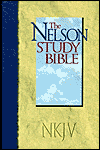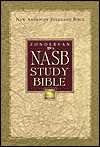| Definition | Comparison Chart | Study Bibles |
| Items
|
New Interpreter's
Study Bible |
New Oxford
Annotated Bible |
NIV
Study Bible |
HarperCollins
Study Bible |
| Number of editors (renowned biblical scholars) | 5 | 4 | 5 | 5 |
| Contributors (renowned biblical scholars) | 63 | 41 | 50 | 61 |
| Introductions to each Book of the Bible | Yes | Yes | Yes | Yes |
| Excursuses (theological theme articles) | Yes | No | No | No |
| Outlines to each Book of the Bible | Yes | No | Yes | No |
| Concordance or chained cross-reference | Yes | Yes | Yes | No |
| Index to Maps | Yes | Yes | Yes | Yes |
| Glossary to terms used in notes | Yes | No | No | No |
| Color maps | 19 | 14 | 14 | 16 |
| Translation | NRSV | NRSV | NIV | NRSV |
| Apocrypha with notes | Yes | Yes | No | Yes |
| Commentary (notes) word count | 1,210,292 | ~800,000 | ~700,000 | ~800,000 |
| Price | $45.00 | $45.00 | $40.00 | $42.00 |
| Leather edition available | Yes | Yes | Yes | Yes |
| Software edition available | Yes (incl. complete IDB) | No | Yes | No |
| Guides for interpretation | Yes | Yes | No | Yes |
| Alphabetical listing of the Books of the Bible | Yes | Yes | Yes | Yes |
| Timeline/chronoligies | Yes | Yes | Yes | Yes |
| NOAB | HCSB | CASB | KJVSB | NSB | NIVSB | ZNASBSB |
 The
New Oxford Annotated Bible: Third Edition
The
New Oxford Annotated Bible: Third Edition
 The HarperCollins Study Bible with Apocryphal/Deuterocanonical Books: New
Revised Standard Version
The HarperCollins Study Bible with Apocryphal/Deuterocanonical Books: New
Revised Standard Version
INTRODUCTION
TO THE
HARPER COLLINS STUDY BIBLE
By Wayne A. Meeks
The Bible is the most familiar book in the English-speaking world; certainly it is the one most often published and most widely owned. Yet many a serious reader has found it one of the strangest of books. This paradox arises from factors in the book's history as well as from dimensions of our own history that have shaped the expectations with which we begin to read.Enabling the Reader to Read
The most elementary of the obstacles standing in the way of reading the Bible is that its component parts were originally written in languages most of us do not know. Reading must therefore begin with a translation. The New Revised Standard Version stands in a tradition, many centuries old, of translating the Bible so that ordinary people can understand it when it is read aloud in worship gatherings or when they study it for themselves. More immediately, the NRSV stands in a direct succession from the King James Version of 1611 (as Professor Metzger explains in the Translation Committee's preface, pp. xxv-xxx). The NRSV is one among a large number of recent translations of the whole or parts of the Bible that together give to the present generation of English readers an unprecedented variety of fresh renderings of the original languages. All these are informed by significant advances in historical, archaeological, and linguistic knowledge that have occurred in recent decades.The NRSV is selected for this "HarperCollins Study Bible "for several reasons, of which two are most significant. First, the declared intention of the Translation Committee to produce a translation "as literal as possible" makes this versionwell adapted for "study." For example, careful reading is enhanced when we can observe such things as the recurrence of certain key words; if these are rendered into our language with some consistency, the task is obviously easier. Second, the NRSV was designed to be as "inclusive "as possible, in two different senses. It includes the most complete range of biblical books representing the several differing canons of scripture (about which more will be said below) than any other English version. In addition, it avoids language that might inappropriately suggest limits of gender.
Yet even the most excellent translation from the Hebrew, Aramaic, and Greek texts cannot by itself completely remove the strangeness that many modern readers sense when they encounter the Bible. It is, after all, an ancient book. Indeed, it is a collection--no, several collections--of books that were formed and written in cultures distant from our own not only in time and space but also in character. Indeed, what is required of us as readers is rather to enter, through these texts, into another world of meaning. Only when we have sensed the peculiarity and integrity of that other world can we build a bridge of understanding between it and our own. The introductions and notes accompanying the text in the "HarperCollins Study Bible "are designed to provide readers with information that will make it easier to use this excellent translation for the deeper kind of translation readers must make for themselves: the actual encounter with the multiple worlds of meaning that these texts can reveal.
With the aim of removing as many obstacles as possible between readers and the text, the notes in this volume provideseveral kinds of information. First, they point to characteristics of the language that are significant for meaning. These include the biblical writers' choice of words, the formal patterns of speech, the styles and genres of ancient literature that appear in the texts, and the rhetorical strategies--familiar to ancient readers but foreign to us--adopted by the writers. Second, the notes contain facts about historical events alluded to in the texts or underlying their message. Many of these facts have come to light through modern archaeological discoveries and the analysis of ancient inscriptions and other material evidence. Comparisons and contrasts between the biblical writings and other writings from around the same time and from the same part of the world also help to place them in their historical context. Third, the notes call attention to echoes between different texts of scripture. Sometimes these are direct quotations or paraphrases of earlier texts by later ones. At other times, they represent parallel formulations of common traditions or retellings of familiar stories in new settings. Fourth, the notes sometimes illuminate ambiguities in the text, multiple possibilities that the original languages leave open but that cannot be directly expressed by a single English translation.
One Book or Many?
Anyone who looks carefully at the Bible will be struck by the immense variety of its contents. Here we have prose and poetry, expansive narratives and short stories, legal codes embedded in historical reports, hymns and prayers, quoted archival documents, quasi-mythic accounts of things that happened "in the beginning" or in God's court in heaven, collections of proverbs,maxims, aphorisms, and riddles, letters to various groups, and reports of mysterious revelations interpreted by heavenly figures. This variety accounts for some of the richness that generations of readers have found within its pages, but it also causes much of the puzzlement even the most devoted readers often feel. How did it come about that so many different kinds of writing have been brought together into one book?This is a question that has preoccupied many modern scholars. They have sought to answer it by investigating the history of the Bible itself. The very word "Bible" is derived from a plural Greek word, "ta biblia," "the little scrolls." A Christian term, the latter refers to the separate rolls of leather or papyrus on which the sacred writings, like other literary works in antiquity, were ordinarily written. The physical limits of the roll meant that many rolls were required for the writings that had come to be held sacred in the Jewish and Christian communities. Sometimes a long document had to be divided into two scrolls, like the books of Samuel and Kings, or the Gospel of Luke and the Acts of the Apostles. As early as the second century, Christians began to use instead the relatively new form of the codex, very much like our modern books. This made it possible actually to put all the sacred writings into one large manuscript--but the name "ta biblia "somehow stuck.
The individual books that make up our Bible were written over a period of more than a thousand years. During that time the people of Israel underwent many changes, even deep transformations, in their national life and culture. Their patterns of government, their cultic and legal organization, and theirrelationships to neighboring peoples and to the great empires of the ancient Mesopotamian and Mediterranean regions all changed. Those changes go far to account for the variety we see in content, language, and style of the biblical books.
Publisher: HARPER COLLINS Publication Date: 01/1994 Binding: Hardcover Item#/ISBN: 0060655267 Retail Price: $34.00 Author: Wayne Meeks Hyperlinks Addall.com listing
 The
NRSV Cambridge Annotated Study Bible
The
NRSV Cambridge Annotated Study Bible
 The
King James Study Bible
The
King James Study Bible
 The Nelson Study Bible (NKJV)
The Nelson Study Bible (NKJV)
 The NIV Study Bible: Revised
The NIV Study Bible: Revised
 Zondervan NASB Study Bible
Zondervan NASB Study Bible